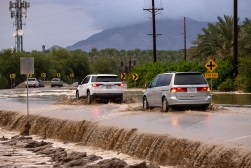California CIO says wildfires website launched ‘in record time’

As wildfires continue to blow through communities around Northern and Southern California, the state’s top technology official says she’s doing what she can to support communication between state agencies and the public.
California Chief Information Officer Amy Tong told StateScoop Wednesday that for the last two weeks, she’s been dialing into an operations center propped up by the California Governor’s Office of Emergency Services to help support the state’s coordinated emergency response and disaster relief. She was activated, along with other state department heads, following power outages initiated by Pacific Gas & Electric, California’s largest utility, days before the fires began.
One of the largest blazes is the Kincade Fire, which as of Thursday has burned through 76,000 acres of wine country north of San Francisco, destroying some 200 houses and other buildings and is now 45 percent contained. Winds kicked up to 70 miles an hour on Wednesday stoking smaller fires in the south, including the Getty Fire, which the Los Angeles Fire Department said threatens more than 7,000 homes.
“We are going through unprecedented challenges in California with the back-to-back power shutoff and the fires in the middle of all this,” Tong said.
Out of caution, the utility eventually cut power to nearly 1 million customers in Northern California but confirmed Wednesday evening that it had restored service to 95 percent of those affected, leaving 53,000 customers without power. According to Gov. Gavin Newsom, the outages are because “for decades, [PG&E] have placed greed before public safety,” as the utility failed to update equipment and allowed vegetation to grow around power lines.
Amid this disruption, Tong said her job has been to assist various agencies, whether they’re those responding to the fires or those playing supporting roles such as the Transportation or Health departments, in communicating critical information to the public — and quickly.
One such project emerged last weekend when Newsom’s office requested the California Department of Technology build a website to serve as a centralized resource for all state and local government information related to the fires and power outages. The website, which went live Monday, pulls together various data sets that were held by the governor’s office, such as maps on fires, air quality and road conditions; information on food banks, shelters and unemployment insurance benefits; and phone numbers for critical services like health care.
“It was definitely done in record time,” Tong said. “From concept to launch it was done in a weekend. The actual coding of it was done in 24 hours.”
Tong said her office, like the other executive agencies, plays only a supporting role, jumping in to help when asked, reconnecting wireless internet service, repairing networking equipment or assisting with standing up websites or assisting with social media. But managing the technology for internal communications between the various response agencies is led by Cal OES and is, “unfortunately,” Tong said, a function the state has become too familiar with as California’s faced wildfires of escalating frequency and severity in recent years.
Communication has also proven a critical function for federal agencies, such as when the National Weather Service issued its first-ever “extreme red flag warning” to more than 26 million people in California and Arizona this week. The use of “extreme” in the warning is not a technical designation but was used to catch the public’s attention, NWS Information Technology Officer Tom Fisher told CNN.
Gov. Newsom has had his eye on wildfires since his first day in office in January when he created a new procurement process designed to encourage adoption of innovative technologies in state government. The first use of this process, which the state calls RFI-squared, came in September when the governor’s office announced the award of two contracts for cutting-edge firefighting technologies — a modeling platform that predicts where active blazes will spread, and an ignition detection system that relies on aerial sensors.
Though the state’s new procurement vehicle was designed for speed, the new technologies were not deployed in time for October’s blazes.






